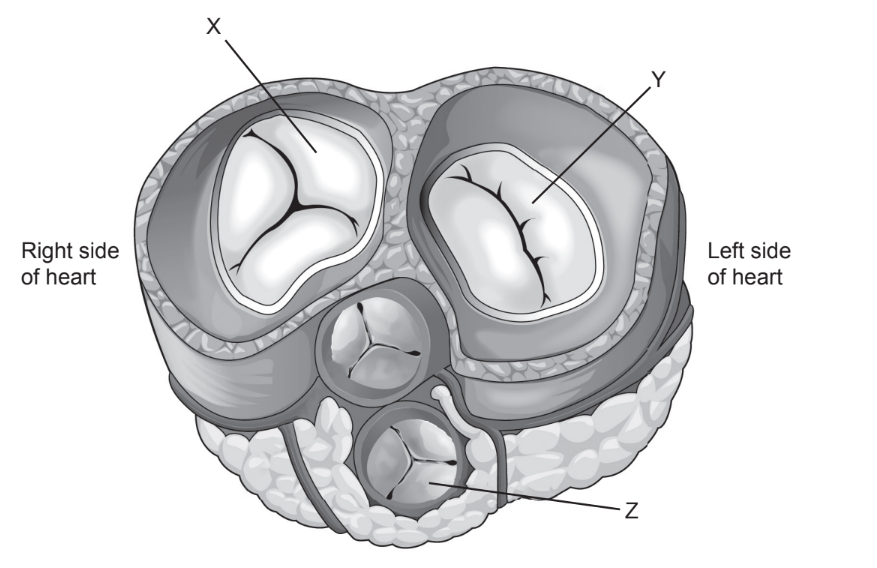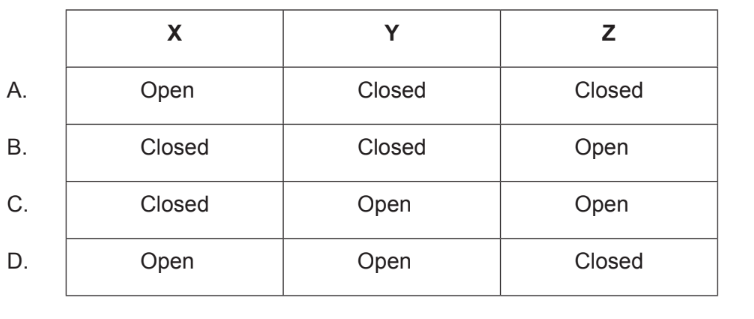IB Biology HL (HIGHER level)- 2024 – Practice Questions- All Topics
Topic 6.2 The blood system
Topic 6 Weightage : 20%
All Questions for Topic 6.2 – Circulation, Arteries, Capillaries, Veins, Vessel Comparison, Heart Structure, Heart Beat, Heart Rate, Cardiac Cycle, Heart Disease, Blood Composition, Blood Pressure, Electrocardiography
Question
What is a property of arteries?
A Arteries have elastic walls.
B Arteries have valves.
C All arteries carry oxygenated blood.
D Arteries receive blood from the atria.
▶️Answer/Explanation
Ans: A
Arteries are muscular blood vessels that carry oxygen-rich blood away from the heart. They have thick and elastic walls that can expand and contract to accommodate the changing blood pressure caused by the pumping action of the heart. The elasticity of the artery walls helps to maintain a steady flow of blood and prevents sudden changes in blood pressure.
Which is a valid comparison between arteries and veins?

▶️Answer/Explanation
Markscheme
C
Blood flows at high pressure in arteries because the heart pumps blood out of the left ventricle and into the aorta, which is the largest artery in the body. The blood then flows through smaller arteries and arterioles, where the high pressure helps to push the blood through the narrow vessels and into the capillaries.
Blood flows at low pressure in veins because the blood has already passed through the capillaries and is returning to the heart. The pressure in veins is lower than in arteries because the resistance to blood flow is lower, and the veins have one-way valves that prevent blood from flowing backward. The low pressure in veins allows blood to flow smoothly back to the heart.
Which discovery was an indication that the heart pumps blood to the body through arteries?
A. The amount of blood pumped exceeds that of blood produced
B. Blood could easily be pushed up a limb vein, but not down
C. The observation that there were pores between the right and left atria
D. The heart swelled up when the arteries were tied in an animal experiment
▶️Answer/Explanation
Markscheme
D
In the early days of medicine, there was a debate on how blood circulated in the body. One of the theories was that the liver produced blood, and the heart was responsible for distributing it to the rest of the body. This theory was challenged by various experiments, including one where an artery was tied off in an animal, and the heart swelled up with blood. This experiment indicated that the heart was responsible for pumping blood to the body through arteries, and it helped to establish the concept of blood circulation as we understand it today.
What is a feature of the human circulatory system?
A. The wall of the right ventricle of the heart is the thickest of the four chambers.
B. The pulmonary artery and vena cava both carry deoxygenated blood.
C. Valves are found in arteries and veins but not capillaries.
D. Epinephrine acts on the pacemaker to reduce heart rate.
▶️Answer/Explanation
Markscheme
B
The pulmonary artery carries deoxygenated blood from the heart to the lungs, where it is oxygenated. The pulmonary vein then carries oxygenated blood back to the heart. The vena cava is the largest vein in the body and carries deoxygenated blood from the body back to the heart. These two vessels are the only ones in the body that carry deoxygenated blood, while all other arteries carry oxygenated blood.
What is a role of the coronary arteries?
A. To supply information about blood temperature to the hypothalamus
B. To supply the heart muscle with oxygen and nutrients
C. To carry blood away from the heart
D. To monitor blood pH
▶️Answer/Explanation
Markscheme
B
The coronary arteries are responsible for supplying the heart muscle with oxygen and nutrients. The heart is a muscle that requires a constant supply of oxygen to function properly. The coronary arteries branch off the aorta and encircle the heart, supplying the heart muscle with oxygen and nutrients. If the coronary arteries become blocked or damaged, it can lead to a heart attack or other serious heart problems.
What causes heart ventricles to fill with blood?
I. Atrial contraction
II. Closing of atrio-ventricular valves
III. Opening of semilunar valves
A. I only
B. I and II only
C. II and III only
D. III only
▶️Answer/Explanation
Markscheme
A
The heart ventricles fill with blood due to the contraction of the atria and the closing of the atrioventricular valves. When the atria contract, blood is pushed into the ventricles. The atrioventricular valves then close to prevent blood from flowing back into the atria during ventricular contraction. Once the ventricles are full, they contract and the semilunar valves open, allowing blood to flow out of the heart and into the arteries.
Question
The diagram shows a staggered transverse section (cut across rather than down) through the heart.

In what state are the valves when the ventricles are contracting?

▶️Answer/Explanation
Ans:B
In the diagram, X is tricuspid valve, Y is bicuspid valve and Z is aortic valve.
When the left ventricle contracts, the mitral valve closes and the aortic valve opens. This is so blood flows into the aorta and out to the rest of the body. While the left ventricle is relaxing, the right ventricle also relaxes. This causes the pulmonary valve to close and the tricuspid valve to open.
